Blog Archive: May 2025
Week 8 / How We Collected $47 in Premiums This Week with NVDA Credit Spreads
| | 82 seen
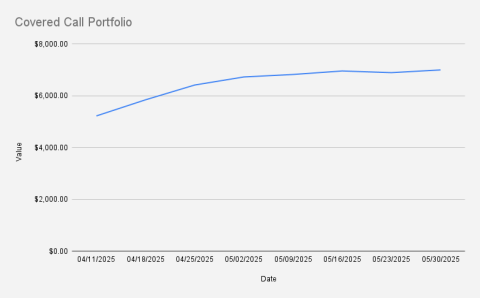
As of May 30, 2025, our covered call stock portfolio stood at $6,993, showing a +1.53% week-over-week increase (+$105). While Year-to-date, we are still down -7.26%, as we navigate volatility while optimizing our options income strategy.
This week was particularly interesting—there was NVDA earning report and I discovered another options trader who is documenting his journey to $100K through weekly blog updates. I highly recommend checking it out. Since our portfolio sizes are currently similar, I find it both motivating and insightful to follow along and compare strategies as we grow together.
We successfully closed a credit spread on NVDA that expired worthless, allowing us to retain the full premium. Continuing our premium collection strategy, we've initiated a new credit spread set to expire next week.
Following NVDA’s stronger-than-expected earnings report, the stock at one moment surged past $140, with dipping back to $134 at the end of week. We currently hold a covered call with a $109 strike expiring on June 27, which is now significantly deep in the money. If we allow the shares to be…
Larnaca International Airport
| Airports | 14 seen
This spring, I took a memorable trip that involved connecting through three countries in less than two weeks—starting in Tbilisi, Georgia, spending a few days in Israel, and finally heading to Cyprus for a short but enriching stay. What stood out most was just how short and easy the flight was between Israel and Cyprus—a route I had never seriously considered before.
Our journey began in Tbilisi, flying to Tel Aviv's Ben Gurion Airport, where we stayed for several days to visit relatives. These family moments added a personal and grounding start to what would soon shift into a more exploratory leg of the trip.
After spending quality time in Israel, we boarded a short flight from Tel Aviv to Larnaca with Israir, a regional airline we had used once flying to Eiltat. The flight was incredibly short—less than an hour—and gave me a new appreciation for the geographic closeness of Israel and Cyprus. It’s a route so brief it feels more like a long taxi ride than a traditional international flight.
Larnaca International Airport (LCA) welcomed me with a modern but slightly cold atmosphere. The terminal is clean and well-organized, and everything works as it should.…
Frame House Upgrades: Big Windows, New Porch, and Apple Trees Planted in Latvia
| Frame House | 283 seen
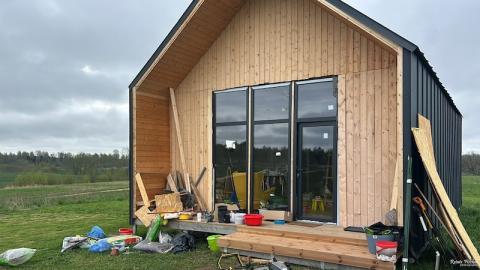
In mid-April, during our kiddo’s Easter school break, we traveled to Latvia for about 10 days — a trip packed with projects, energy, and transformation. A lot of pre-planning had gone into it before we even arrived: we ordered the windows, sourced the plants, and mapped out the main tasks. Once we landed, it was all about execution — and we got a lot done.
One of the most transformative updates was installing our huge 3x3 meter windows. In the end I decided to split them into 1X3X3
These oversized panes completely changed the feel of the house — flooding the space with natural light and giving us panoramic views of the land. Now, no matter where you stand, the outdoors feels just a step away. It’s the kind of upgrade that doesn’t just look good — it feels good.
While the windows were the big highlight, we also extended the porch with a new step. It’s a simple touch but made a real difference, making the entrance more functional and giving the front of the house a more finished look. Sometimes, it's the little improvements that pull everything together.
Outdoors, the serious work continued. Our goal was to plant at least 20 apple trees this spring — an…
Week 7 / How I’m Using Covered Calls and Credit Spreads to Pay Off Margin on NVDA Stock
| | 114 seen
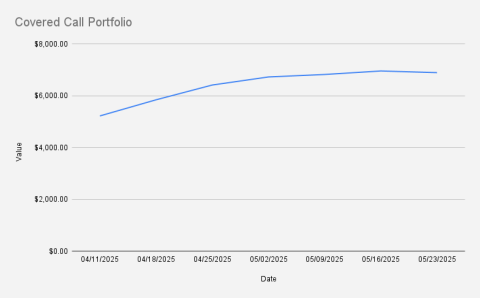
As of May 23, 2025, our covered call stock portfolio stands at $6,888, reflecting a -0.93% week-over-week decline (down $64.48). Year-to-date, we are down -9.33%, as we navigate volatility while optimizing our options income strategy.
Rolling NVDA Calls for Controlled UpsideThis week, we rolled our NVDA covered call to the June 27, 2025 expiry, raising the strike to $109. Should NVDA close at or above that level at expiry, the position would yield a maximum profit of around $150. However, we remain focused on retaining the shares rather than letting them be called away. If momentum continues, we’re ready to roll the strike higher to maintain upside exposure and capture premium.
Credit Spreads for Additional Yield – But With Margin RiskTo compensate for the lower near-term yield from the longer-dated call, we initiated a weekly credit spread on NVDA. This trade supplements income but adds considerable margin risk.
Currently, our portfolio carries a …
Pūre Horticultural Research Station
| Shopping Venues | 27 seen
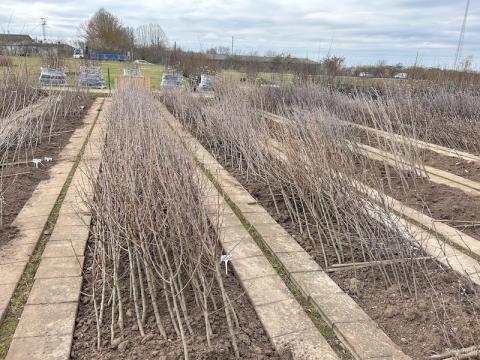
In mid-April 2025, we took an exciting step toward our vision of a Latvian craft cider brewery by purchasing several Antonovka apple trees and other varieties from the renowned Pūre Horticultural Experimental Station (Latvian: Pūres dārzkopības izmēģinājumu stacija).
This wasn’t a random choice. Pūre is one of Latvia’s most respected institutions in plant cultivation and horticultural research. With decades of hands-on experience in the Latvian climate, they offer proven expertise in selecting trees and plants that can thrive through our seasons — cold winters, unpredictable springs, and all.
Their staff provided solid recommendations not only for Antonovka, which is famous for its hardiness and perfect acidity for cider production, but also for several other fruit trees and shrubs suited for our longer-term expansion plans.
Antonovka is a classic Soviet-era apple cultivar, known for:
- Excellent cold resistance
- Sharp, tart flavor ideal for cider
- Reliable harvests in Baltic and Nordic climates
It’s no…
Week 6 / Doing Nothing, Gaining 1.98%: A Covered Call Strategy That Pays
| | 65 seen
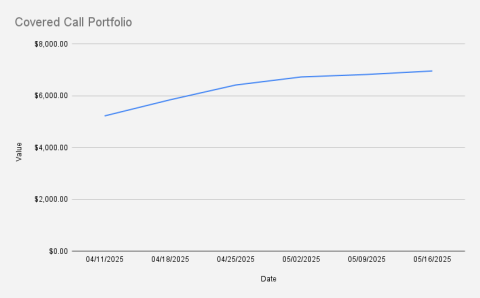
In the world of trading, action often feels like progress. Placing new trades, adjusting positions, chasing setups—these behaviors can give us the illusion of control. But sometimes, the most profitable move is to simply do nothing.
As of May 16, 2025, our covered call stock portfolio was valued at $6,952, reflecting a 1.98% week-over-week gain (+$134.96). That’s a modest but welcome increase, especially considering that we didn’t place a single new trade this week.
Despite this recent uptick, we are still down -7.01% year-to-date, a reminder of the rocky terrain we’ve traversed in 2025. Yet even during this downturn, opportunities for calm, calculated growth remain.
This week, there were no covered calls expiring in our portfolio, and no new positions were opened. We’re currently focused entirely on a single NVDA covered call, with the nearest expiry on May 23—just one week away.
While it might seem counterintuitive, this narrow focus is deliberate. Rather than…
Samshvilde Canyon Hiking
| Living in Georgia | 51 seen

Our go-to hiking spot in Georgia has always been Birtvisi Canyon. With its striking rock formations, narrow passages, and unbeatable views, it’s a place we return to again and again. But last Sunday, we felt like trying something new.
So we picked a place we’d heard about but never explored properly: Samshvilde Canyon.
In fact we almost find it few years ago, but turned our car around because the road didn't seem proper. See: Hiking at Birtvisi Canyon. This time we risked bit more.
Located not far from the town of Tetritskaro, Samshvilde is known for its quiet trails and historic ruins, including the remains of the ancient Samshvilde Fortress. We packed up for a casual day hike, hoping for some nice views and maybe a peek at the fortress.
After a peaceful countryside drive, we found a small parking spot near the edge of the canyon. The trails were actually marked, which was a pleasant surprise — but we still weren’t entirely sure where we were going. With no detailed map and limited phone signal, we decided to follow a route that seemed to lead toward Pirghebuli…
Week 5 / NVDA Rally Forces Covered Call Adjustment: Rolling Up and Out for a Credit
| | 55 seen
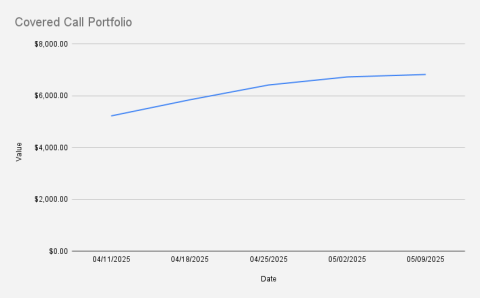
As of May 9, 2025, our covered call stock portfolio was valued at $6,818, reflecting another 1.42% week-over-week gain (+$95.42). Despite the recent uptick, we remain down -9.63% year-to-date.
Currently, the entire covered call portfolio is allocated to NVDA stock.
With NVDA rallying sharply, our May 9 $107 call moved deep in-the-money. Although my initial plan was to let the shares be called away and then re-enter via cash-secured puts, I decided to roll the position up and out for a net credit instead.
Unfortunately, weekly expiries offered unattractive premiums, so I rolled into the May 23 expiration:
- Bought back the May 9 $107 call for $10.62
- Sold the May 23 $108 call for $11.03
- Net premium collected: $0.41 per share
- Break-even price: $103.9
While the two-week premium of…
How I Upgraded XTRF on Ubuntu with PostgreSQL 14 (and Fixed Every Broken Dependency)
| Servers | 42 seen
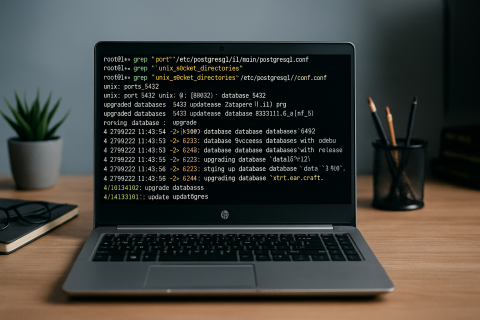
Upgrading an XTRF instance—especially one that has aged alongside older OS and database stacks—is never a walk in the park. In this article, I’ll walk you through the real-world path I took, upgrading from Ubuntu 18.04 all the way to 22.04, aligning PostgreSQL to a supported version, and overcoming the nuanced issues involved in deploying XTRF on Jboss. Most importantly, I’ll highlight how AI—specifically ChatGPT—helped me tackle the hard problems, including log file analysis and patching .war deployments.
XTRF is a popular Translation management system we use at our Translation company in Tbilisi
Our system was running on Ubuntu 18.04 LTS with PostgreSQL 11, which shipped by default with that version. This setup had served us well in the past, but it was becoming increasingly clear that support was fading and incompatibilities with newer XTRF versions were stacking up. I had already encountered an unsuccessful upgrade attempt in the past, so this time I decided to take a much more structured and cautious approach.
Now, if you already have system all up and running, you could simply run:
sudo apt-get install xtrf10-full
Incremental Ubuntu…David Baazov Museum of History of the Jews of Georgia and Georgian-Jewish Relations
| Museums | 91 seen

Tbilisi is a city full of hidden corners, rich history, and quiet treasures, one of which I recently discovered: the David Baazov Museum of History of the Jews of Georgia and Georgian-Jewish Relations.
Over the years, I've gradually learned that Georgia has a deeply rooted Jewish presence. There's even a Jewish Quarter in Tbilisi, which I came across during my many walks through the city's charming old streets. Historically, Jewish communities have lived in Georgia for centuries — a fact that, at first, surprised me. My curiosity about this history grew even stronger after meeting a Georgian Jew during a visit to Israel, a moment that further highlighted the global and interconnected nature of this community.
Although Tbilisi has several synagogues, I must admit that I haven’t visited any of them yet. They are on my list, of course. Wandering around Tbilisi one afternoon, I happened to notice a modest-looking building tucked into the urban landscape — the Jewish Museum. On a whim, I decided to pay a visit.
The David Baazov Museum is not large…
Week 4 / NVDA Covered Call Strategy: Earning $83 This Week To Pay of Margin Debt
| | 48 seen
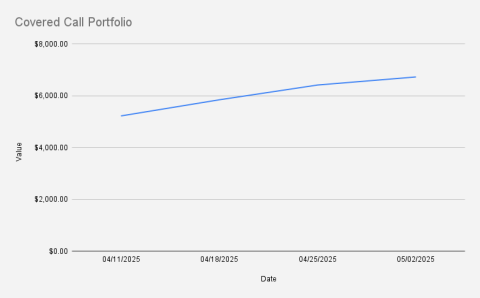
As of May 2, 2025, our covered call stock portfolio was valued at $6,722, reflecting another strong 4.85% week-over-week gain. However, we still remain down -11.61% year-to-date.
Our covered call portfolio at the moment is centered around NVDA stock exclusively.
As of today our covered call position was in the money and, I decided to roll forward this position,
Here is the trade setup:
- Bought back the May 2 $107 call for $7.75
- Sold the May 9 $107 call for $8.59
- Premium collected: $0.83 per share
- Break-even: $104.29
I initially wanted to roll this position up and away, but since it was already deep in the money, doing so would have required either choosing a different expiry or paying down debt. I preferred not to do the latter, as we’re using margin to finance the NVDA trade. One of our main goals is to reduce margin exposure as quickly as possible. That’s why I decided to stick…
April 2025 Stock Portfolio Update ($6,629)
| Stock Portfolio | 29 seen
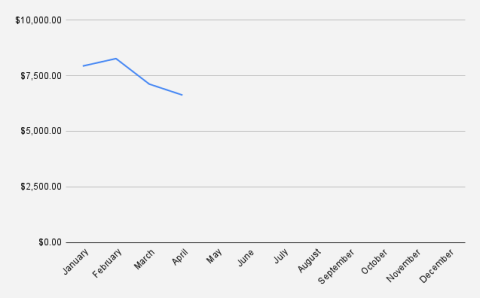
At the end of April 2025, the total value of our stock portfolio stood at $6,629 (€6,594), down from $7,124 a month earlier. That’s a -6.94% decrease in portfolio value, or -$495 in dollar terms.
Yes, it stings — ouch — but it’s also part of a larger strategy pivot. We’re confident that with the NVDA covered call strategy, we’ll not only stabilize but begin generating consistent returns starting May.
April was a transformative month — both financially and personally. While our stock portfolio took a hit for the second month in a row, we made meaningful changes that lay the groundwork for a more strategic, income-focused approach. Meanwhile, on the personal front, we spent about 10 days in Latvia, enjoying springtime and putting serious work into our frame house project.
Over the course of 10 days, we focused on our wooden frame house, making significant progress. One of the biggest accomplishments was installing large 3x3 meter panoramic windows — a major improvement that enhanced both the functionality and aesthetics of the home.
We also got our hands dirty in the…